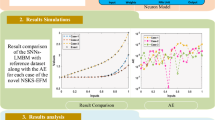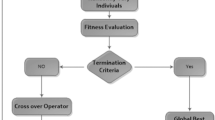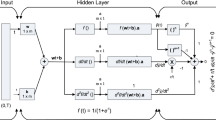Abstract
In this study, new intelligent computing methodologies have been developed for highly nonlinear singular Flierl–Petviashivili (FP) problem having boundary condition at infinity by exploiting three different neural network models integrated with active-set algorithm (ASA). A modification in the modeling is introduced to cater the singularity, avoid divergence in results for unbounded inputs and capable of dealing with strong nonlinearity. Three models have been constructed in an unsupervised manner for solving the FP equation using log-sigmoid, radial basis and tan-sigmoid transfer functions in the hidden layers of the network. The training of adaptive adjustable variables of each model is carried out with a constrained optimization technique based on ASA. The proposed models have been evaluated on three variants of the two FP equations. The designed models have been examined with respect to precision, stability and complexity through statistics.










Similar content being viewed by others
References
Flierl GR (1979) Baroclinic solitary waves with radial symmetry. Dyn Atmos Oceans 3(1):15–38
Petviashvili VI (1981) Red spot of Jupiter and the drift soliton in a plasma. JETP Lett 32:619–622
Boyd JP (1991) Monopolar and dipolar vortex solitons in two space dimensions. Wave Motion 13:223–241
Chandrasekhar S (1967) Introduction to the study of stellar structure. Dover Publications, New York
Shawagfeh NT (1993) Nonperturbative approximate solution for Lane-Emden equation. J Math Phys 34(9):4364–4369
Wazwaz AM (2001) A new method for solving differential equations of the Lane-Emden type. Appl Math Comput 118(2/3):287–310
Wazwaz AM (2005) Analytical solution for the time-dependent Emden-Fowler type of equations by Adomian decomposition method. Appl Math Comput 166:638–651
Wazwaz AM (2002) A new method for solving singular initial value problems in the second order ordinary differential equations. Appl Math Comput 128:47–57
Wazwaz AM (1999) A reliable modification of Adomian’s decomposition method. Appl Math Comput 102:77–86
Wazwaz AM (1999) The modified decomposition method and the Padé approximants for solving Thomas-Fermi equation. Appl Math Comput 105:11–19
Wazwaz AM (1999) Analytical approximations and Padé approximants for Volterra’s population model. Appl Math Comput 100:13–25
Wazwaz AM (2006) Pade approximants and Adomian decomposition method for solving the Flierl–Petviashivili equation and its variants. Appl Math Comput 182:1812–1818
Mohyud-Din ST, Noor MA (2008) Homotopy perturbation method and Padé approximants for solving Flierl–Petviashivili equation. Appl Appl Math 3(2):224–234
Momani S, Ertürk VS (2010) The solution of Flierl-Petviashivili equation and its variants using Dtm-Padé technique. World Appl Sci J 9((Special Issue of Applied Math)):32–38
Raja MAZ, Khan JA, Chaudhary NI, Shivanian E (2016) Reliable numerical treatment of nonlinear singular Flierl–Petviashivili equations for unbounded domain using ANN, GAs, and SQP. Appl Soft Comput 38:617–636
Abu Arqub O, Maayah B (2016) Solutions of Bagley-Torvik and Painlevé equations of fractional order using iterative reproducing kernel algorithm. Neural Comput Appl. doi:10.1007/s00521-016-2484-4
Abu O (2015) Arqub, Adaptation of reproducing kernel algorithm for solving fuzzy Fredholm–Volterra integrodifferential equations. Neural Comput Appl. doi:10.1007/s00521-015-2110-x
Abu Arqub O, Al-Smadi M, Momani S, Hayat T (2016) Application of reproducing kernel algorithm for solving second-order, two-point fuzzy boundary value problems. Soft Comput. doi:10.1007/s00500-016-2262-3
Abu Arqub O, Al-Smadi M, Momani S, Hayat T (2016) Numerical solutions of fuzzy differential equations using reproducing kernel Hilbert space method. Soft Comput 20:3283–3302. doi:10.1007/s00500-015-1707-4
Raja MAZ, Shah FH, Tariq M, Ahmad I (2016) Design of artificial neural network models optimized with sequential quadratic programming to study the dynamics of nonlinear Troesch’s problem arising in plasma physics. Neural Comput Appl. doi:10.1007/s00521-016-2530-2
Khan JA, Raja MAZ, Syam MI, Tanoli SAK, Awan SE (2015) Design and application of nature inspired computing approach for nonlinear stiff oscillatory problems. Neural Comput Appl 26(7):1763–1780. doi:10.1007/s00521-015-1841-z
Baymani M, Effati S, Niazmand H, Kerayechian A (2015) Artificial neural network method for solving the Navier-Stokes equations. Neural Comput Appl 26(4):765–773
Khan JA, Raja MAZ, Rashidi MM, Syam MI, Wazwaz AM (2015) Nature-inspired computing approach for solving non-linear singular Emden-Fowler problem arising in electromagnetic theory. Connect Sci 27(04):377–396
Raja MAZ, Zameer A, Khan AU, Wazwaz AM (2016) A new numerical approach to solve Thomas-Fermi model of an atom using bio-inspired heuristics integrated with sequential quadratic programming. SpringerPlus 5(1):1400
Raja MAZ (2014) Solution of the one-dimensional Bratu equation arising in the fuel ignition model using ANN optimised with PSO and SQP. Connect Sci 26(3):195–214
Jafarian A, Measoomy S, Abbasbandy S (2015) Artificial neural networks based modeling for solving Volterra integral equations system. Appl Soft Comput 27:391–398
Ahmad I, Raja MAZ, Bilal M, Ashraf F (2016) Bio-inspired computational heuristics to study Lane-Emden systems arising in astrophysics model. SpringerPlus 5(1):1866
Ahmad I, Raja MAZ, Bilal M, Ashraf F (2016) Neural network methods to solve the Lane-Emden type equations arsing in thermodynamic studies of the spherical gas cloud model. Neural Comput Appl. doi:10.1007/s00521-016-2400-y
Sabouri J, Effati S, Pakdaman M (2017) A neural network approach for solving a class of fractional optimal control problems. Neural Process Lett 45(1):59–74
Raja MAZ, Khan JA, Haroon T (2014) Stochastic numerical treatment for thin film flow of third grade fluid using unsupervised neural networks. J Chem Inst Taiwan. doi:10.1016/j.jtice.2014.10.018
Raja MAZ (2014) Stochastic numerical techniques for solving Troesch’s Problem. Inf Sci 279:860–873
Majeed K, Masood Z, Samar R, Raja MAZ (2017) A genetic algorithm optimized Morlet wavelet artificial neural network to study the dynamics of nonlinear Troesch’s system. Appl Soft Comput 56:420–435
Raja MAZ, Samar R (2014) Numerical treatment for nonlinear MHD Jeffery–Hamel problem using neural networks optimized with interior point algorithm. Neurocomputing 124:178–193. doi:10.1016/j.neucom.2013.07.013
Raja MAZ, Shah FH, Alaidarous ES, Syam MI (2017) Design of bio-inspired heuristic technique integrated with interior-point algorithm to analyze the dynamics of heartbeat model. Appl Soft Comput 52:605–629. doi:10.1016/j.asoc.2016.10.009
Arqub OA, Abo-Hammour Z (2014) Numerical solution of systems of second-order boundary value problems using continuous genetic algorithm. Inf Sci 279:396–415
Raja MAZ, Khan JA, Shah SM, Samar R, Behloul D (2015) Comparison of three unsupervised neural network models for first Painlevé Transcendent. Neural Comput Appl 26(5):1055–1071. doi:10.1007/s00521-014-1774-y
Momani S, Abo-Hammour ZS, Alsmadi OM (2016) Solution of inverse kinematics problem using genetic algorithms. Appl Math Inf Sci 10(1):225
Raja MAZ (2014) Numerical treatment for boundary value problems of pantograph functional differential equation using computational intelligence algorithms. Appl Soft Comput 24:806–821
Raja MAZ, Manzar MA, Samar R (2015) An efficient computational intelligence approach for solving fractional order Riccati equations using ANN and SQP. Appl Math Model 39(10):3075–3093. doi:10.1016/j.apm.2014.11.024
Masood Z, Majeed K, Samar R, Raja MAZ (2017) Design of Mexican Hat Wavelet neural networks for solving Bratu type nonlinear systems. Neurocomputing 221:1–14
Raja MAZ, Niazi SA, Butt SA (2017) An intelligent computing technique to analyze the vibrational dynamics of rotating electrical machine. Neurocomputing 219:280–299
Mohyud-Din ST, Noor MA, Noor KI (2009) Variational iteration method for solving Flierl–Petviashivili equation using He’s polynomials and Padé approximants. World Appl Sci J 6(9):1298–1303
Mohyud-Din ST, Noor MA, Noor KI (2010) Comparison and coupling of polynomials for Fierl–Petviashivili equation. Math Comput Appl 15(2):187–198
Raja MAZ, Khan MAR, Mahmood T, Farooq U, Chaudhary NI (2016) Design of bio-inspired computing technique for nanofluidics based on nonlinear Jeffery–Hamel flow equations. Can J Phys 94(5):474–489
Raja MAZ, Shah FH, Khan AA, Khan NA (2016) Design of bio-inspired computational intelligence technique for solving steady thin film flow of Johnson-Segalman fluid on vertical cylinder for drainage problem. Taiwan Inst Chem Eng 60:59–75. doi:10.1016/j.jtice.2015.10.020
Raja MAZ, Shah FH, Syam MI (2017) Intelligent computing approach to solve the nonlinear Van der Pol system for heartbeat model. Neural Comput Appl. doi:10.1007/s00521-017-2949-0
Wang L (2005) Support vector machines: theory and application. Springer, Berlin
Gill PE, Murray W, Saunders MA (2006) User’s guide for SNOPT Version 7: Software for large-scale nonlinear programming. Numerical Analysis Report 06-2, Department of Mathematics, University of California, San Diego, La Jolla, CA
Gill PE, Murray W, Saunders MA (1995) User’s guide for QPOPT 1.0: a FORTRAN package for quadratic programming. Report SOL 95-4, Department of Operations Research, Stanford University, Stanford, CA
Gill PE, Murray W, Saunders MA (2006) User’s guide for SQOPT Version 7: Software for large-scale linear and quadratic programming. Numerical Analysis Report 06-1, Department of Mathematics, University of California, San Diego, La Jolla, CA
Gould NIM, Orban D, Toint PL (2003) GALAHAD, a library of thread-safe Fortran 90 packages for large-scale nonlinear optimization. ACM Trans Math Softw 29(4):353–372
Judice JJ, Sherali HD, Ribeiro IM, Faustino AM (2007) Complementarity active-set algorithm for mathematical programming problems with equilibrium constraints. J Optim Theory Appl 134(3):467–481
Hager WW, Zhang H (2006) A new active set algorithm for box constrained optimization. SIAM J Optim 17(2):526–557
Sloan SW (2005) A steepest edge active Set algorithm for solving sparse linear programming problems. Int J Numer Method Eng 26(12):2671–2685
Nocedal J, Wright ST (2006) Numerical optimization, 2nd edn. Springer, Berlin. ISBN 978-0-387-30303-1
Wong E (2011) Active-set methods for quadratic programming. Ph.D. Thesis, University of California, San Diego, USA
Mohyud-Din ST, Yildirim A (2009) Solving nonlinear boundary value problems using He’s polynomials and Padé approximants. Math Probl Eng 2009. Article ID 690547
Mohyud-Din ST, Usman M, Yildirim A (2010) An iterative algorithm for nonlinear BVPS using Pade approximants. World Appl Sci J 10(6):637–644
Author information
Authors and Affiliations
Corresponding author
Ethics declarations
Conflict of interest
The authors declare that they have no competing interests.
Appendix
Appendix
Complete expressions for the solution of the proposed scheme with fourteen places of decimal are provided here for the reproduction and verification of the results. Same equation numbers are referred here for better identification with the main manuscript text.
Rights and permissions
About this article
Cite this article
Raja, M.A.Z., Khan, J.A., Zameer, A. et al. Numerical treatment of nonlinear singular Flierl–Petviashivili systems using neural networks models. Neural Comput & Applic 31, 2371–2394 (2019). https://doi.org/10.1007/s00521-017-3193-3
Received:
Accepted:
Published:
Issue Date:
DOI: https://doi.org/10.1007/s00521-017-3193-3




